Lockheed Hudsons, FH376 and EW904, Donegal, 1942
During the summer of 1942, the Royal Air Force's 44 Group of Ferry Command expanded the operations that had been growing during the previous year, the never ending task of delivering multi engine bomber, patrol and transport aircraft from North American factories to the war zones in Europe and North Africa. At least ten these aircraft found themselves over Ireland or its seas during 1942 in some form of distress. This is the story of two of those aircraft that were able to fly away under their own power after their emergency landings.
The morning of 4th of May, 1942, witnessed one of these
aircraft landing at Pollan Strand, Ballyliffen in Donegal. The
crew, lost and running low on fuel were sent on their way later
that day after refueling and rest. They consisted of two RAF
officers and a Sergeant of the Royal Canadian Air Force.
The aircraft landed at 07:30 in the morning. With the
help of the Irish army it was arranged that fuel would be sent
to the aircraft from Derry via Buncrana in Donegal.
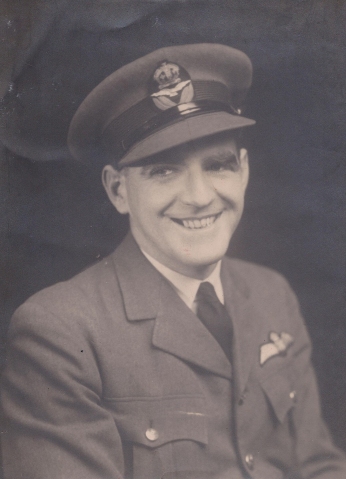 S/Ldr Lionel Rees COHEN 39497 |
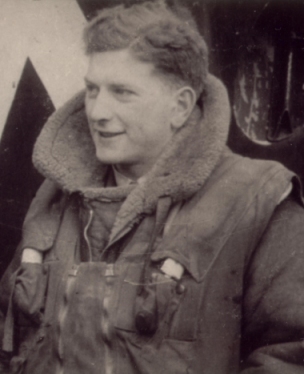 P/O Alexander MORE 103522 DFC |
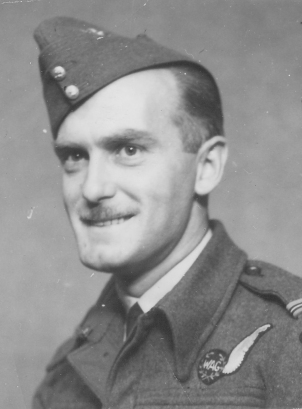 Sgt Eric Jackson GREENHALGH R/103618 RCAF |
Lionel Rees COHEN was an Australian serving in the Royal Air Force. Born in 1912 in Lismore, New South Wales, he was the son of Reginald Arthur and Gwendoline Cohen; husband of Caroline Mary Cohen, of Nevern, Pembrokeshire. Having been commissioned in 1937 into the RAF, he held the rank of Squadron Leader at the time of the landing in Ireland. He married Mary C Gabriel in Tenby, Wales in late 1939 and his son Mike was kind enough to supply the above photo.
The Courier Mail from Brisbane on 7th December 1939 published
the following article.
U-BOAT SUNK BY AUSTRALIAN
SYDNEY, Wednesday.— flying Officer Lionel Rees Cohen, of the
Royal Air Force, and formerly of Sydney, stated in a letter
to his mother, who lives in Kurraba Road, Neutral Bay, that
he had sunk a German submarine.
He gave no details of the sinking, but mentioned it casually
at the end of his letter. '
Flying Officer Cohen, who is 27, has been attached to the
Royal Air Force for three years, and before that spent two
years in Rabaul. He applied for enrollment in the R.A.F.
from Rabaul, and was instructed to present himself
immediately. He worked his passage to England. Before
joining the R.A.F. he had had no previous flying
experience. He soon graduated to flying officer, and
at the outbreak of war was a navigation instructor at the
Navigation School at Manston, Kent.
In the early part of 1939 he was it seems posted to the School
of Air Navigation at RAF Manston in Kent. It is unclear
what the U-boat attack is that is referred to in many wartime
articles in Australia.
Lionel had been posted as a flight commander at 31 Air
Navigation School at Port Albert since December 1940, when the
unit had been moved there from St Athan in South Wales.
It was there that he was joined by his wife and where his son
was born. This flight in Hudson FH376 was his only flight
with Ferry Command and was the RAF's means of getting him back
to the UK. He was posted to 150 Squadron and was sadly
killed in action on the 30th of July 1942 with his crew of four
when their aircraft, Wellington BJ881 was shot down over France
on a raid on Saarbrueken in Germany. He is buried in
France. He he spent only one weekend with his family
following his return before his death. The Daily Telegraph
from new South Wales carried the following article about his
death on 29 April 1945.
Life risked for airman's watch
A cigarette case and watch belonging to an Australian airman
shot down over France in July, 1942, have been returned to
his widow.
They were taken from the airman's clothes after the crash
and hidden from the Germans by a French patriot at the risk
of his life.
The airman was the late Squadron-Leader Lionel Rees Cohen, a
Wellington flight-commander, who was serving with the R.A.F.
His mother, Mrs. R. A. Cohen, of Kurraba Road. Neutral Bay,
has just been informed by her daughter-in-law, an English
nursing sister, that full advice of Squadron-Leader Cohen's
death has been received from the Air Ministry.
The Ministry returned the personal belongings of the late
airman, including his wife's wedding present to him, a
silver cigarette case surmounted with an R.A.F. crest, and a
wristlet watch.
Hidden From Germans
The Air Ministry letter to Squadron-Leader Cohen's wife
said:
"A very brave French patriot, Monsieur Henon Deseigne, of
Pas-de-Calais, risked his life to go secretly to the beach
where your husband and his crew had crashed.
"When he saw that fie could not save their lives, he took
all their personal belongings so that the Germans would not
get them.
"He kept the things hidden until the urea was liberated last
August."
Cohen was the first Australian airman of this war to sink a
Nazi U-boat — in the Bay of Biscay in November, 1939.
He joined the R.AJF. in 1936.
He left one son, Michael Laurence, born five months after he
was killed.
Alexander More was a young navigator from the Royal Air Force Volunteer Reserve born in Glasgow 1917.
His son recalled his fathers memories of the events leading up
to and including the landing in Donegal: When my father
landed at Ballyliffin they were of course very low on fuel,
the prevailing tailwinds over the Atlantic had not been as
strong as forecast. This strong tailwind was needed for the
Hudson to make it non stop from Gander to Prestwick. After the
landing my father persuaded the Pilot and crew to turn their
RAF tunics inside out so that they could bluff the Irish
authorities into thinking that they were a civilian ferry crew
and not be interned for the rest of war. Also my father had a
Glaswegian accent which he thought at time the authorities
might be more sympathetic to as all the rest of the crew spoke
with a pronounced English RAF accent.
At the end of 1941 he was posted to 31 Air Navigation School
RAF Port Albert, Goderich, Ontario to train as a Navigator
Instructor. Whilst in Canada he met and married my mother
Helen Evans who lived in West Lorne. By giving his address as
West Lorne he felt it would favor the crew's chances of being
allowed to fly the Hudson on to Prestwick. What the deciding
factor was in all the events I don't know but they were given
several 5 Gall. jerry cans and were taken to a fuel store to
fill them up and after many hours of going ' to and fro' they
managed to put enough fuel on board to get them to Eglinton
near 'Derry in Northern Ireland and from there to Prestwick.
My Father and his crew were treated very kindly when they
dropped in at Ballyliffin and he recalled the events of that
time with a certain amount of fondness and amusement.
During a subsequent posting to Canada, F/Lt More was reported upon in the Fleet Aircraft Limited magazine, PLANE TALK. This was published during war time probably during his 31 ANS from 1942 to 1944 and is interesting in that it mentions the landing in Ireland and the avoidance of internment.
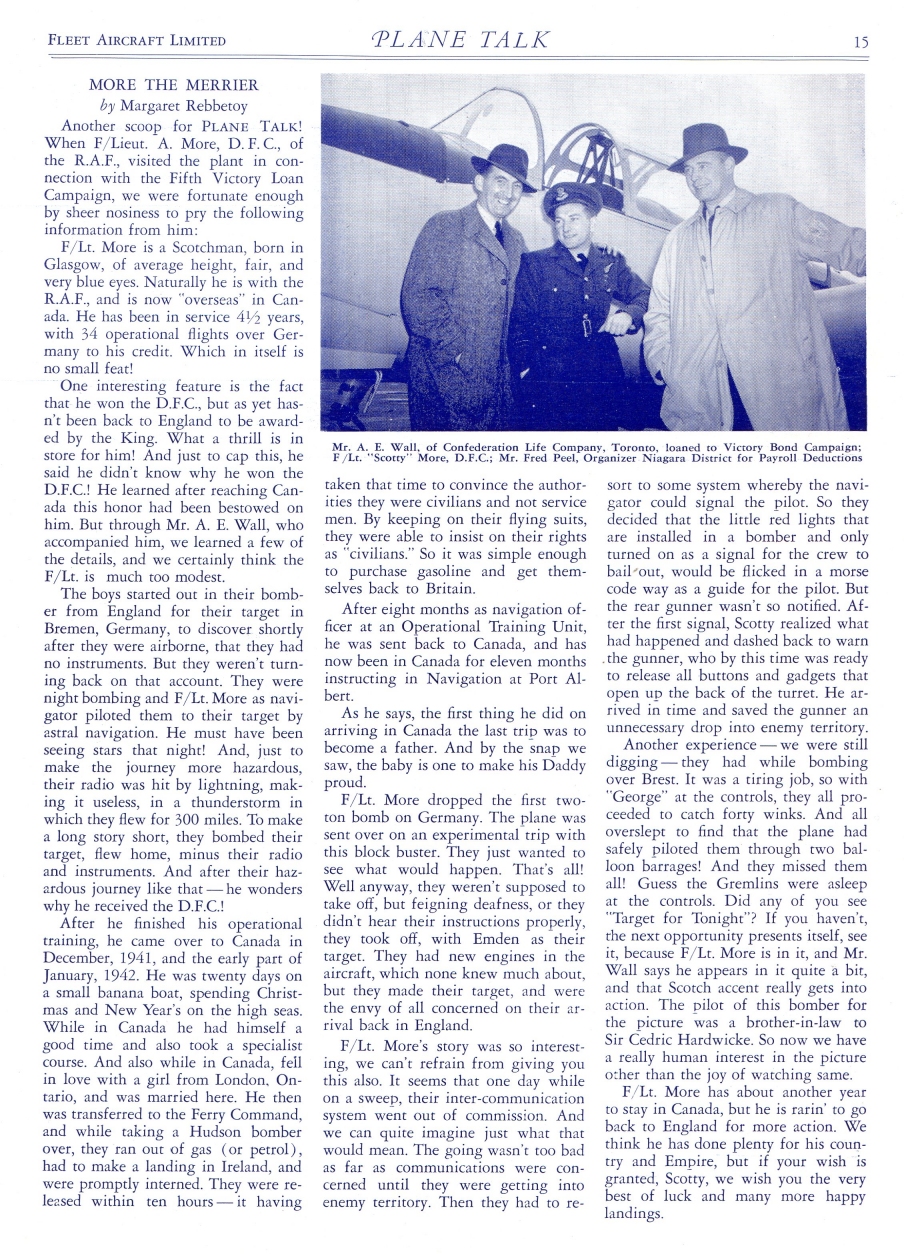
Alex More finished the war as Flt/Lt. Alexander More D.F.C. s/n 755331. He joined the V.R. in July 1939 with Navigator training at Perth and Prestwick, 1940 at the Wellington OTU Lossiemouth. There he was crewed up and in early 1941 was posted to 149 squadron at Mildenhall, Suffolk. He flew 34 bombing missions and it was during this time that the squadron were used for the filming of the motion picture, 'Target for Tonight". From 1942 to Oct. 1944 he was mostly in Port Albert, Canada doing Navigation training. Whilst at Port Albert he obtained his 'SPEC.N' qualification which was Specialized Air Navigator, then late in 1944 converted to Lancaster's with 227 squadron at Balderton and Strubby and latterly on Mosquitoes with 608 squadron at Downham Market and 692 Squadron at Gransden Lodge. After the war he joined BSAA flying down to South America during which he trained as a pilot and he eventually retired from BOAC as a VC10 Captain in 1973. Alex passed away in Surrey in early 2001.
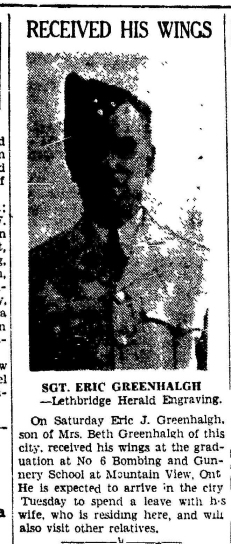
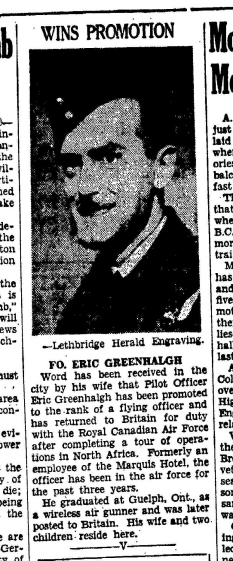 Eric J
Greenhalgh was born in Lancashire, England in 1909. He
moved to Canada in 1921 with his family and they settled in
Alberta, Canada. He enlisted in 1941 and trained as a Wireless
Operator Air Gunner. The flight on FH376 was his only ferry
flight and was his posting to Europe. His postings after this
are unknown but some idea can be gathered from the newspaper
cutting from the Lethbridge Herald Newspaper in 1944.
Eric J
Greenhalgh was born in Lancashire, England in 1909. He
moved to Canada in 1921 with his family and they settled in
Alberta, Canada. He enlisted in 1941 and trained as a Wireless
Operator Air Gunner. The flight on FH376 was his only ferry
flight and was his posting to Europe. His postings after this
are unknown but some idea can be gathered from the newspaper
cutting from the Lethbridge Herald Newspaper in 1944.
A long article in April 1944 discussed his service in depth,
reporting that after his flying to England in "April 1942", he
was posted to India after a further period of training in
England. He was there stationed near Calcutta for eight
months, taking part in operations over Burma. He was next
posted to the Middle East and is said to have taken part in the
July 1943 Sicilian Campaign and the landings in Italy.
January 1944 seen him posted back to the United Kingdom, and was
back in Lethbridge at the time the article was published.
Interestingly, he is said in the newspaper to have a 'Goldfish
Club' badge due to having been shot down off Sardinia. He
spent eight hours in a dinghy before being rescued by a Royal
Navy vessel.
A cutting from 1941 recorded his graduation from training also.
He returned to Canada after the war and raised his family in
Lethbridge, Alberta. He was a leading member of the Lethbridge
Army, Navy and Air Force Association after the war and his name
appears frequently in the local newspapers in relation to this.
He told his daughters little about his wartime service and left
little more in terms of records. He passed away at the age of
92. A descendant of his in laws provided the photo above.
Alexander More's son Evan was kind enough to share a copy of the page of his fathers log book showing the landing in Donegal. The aircraft was flown to Eglinton just across the border in Northern Ireland and from there onto the RAF Ferry Command base at Prestwick in Scotland.
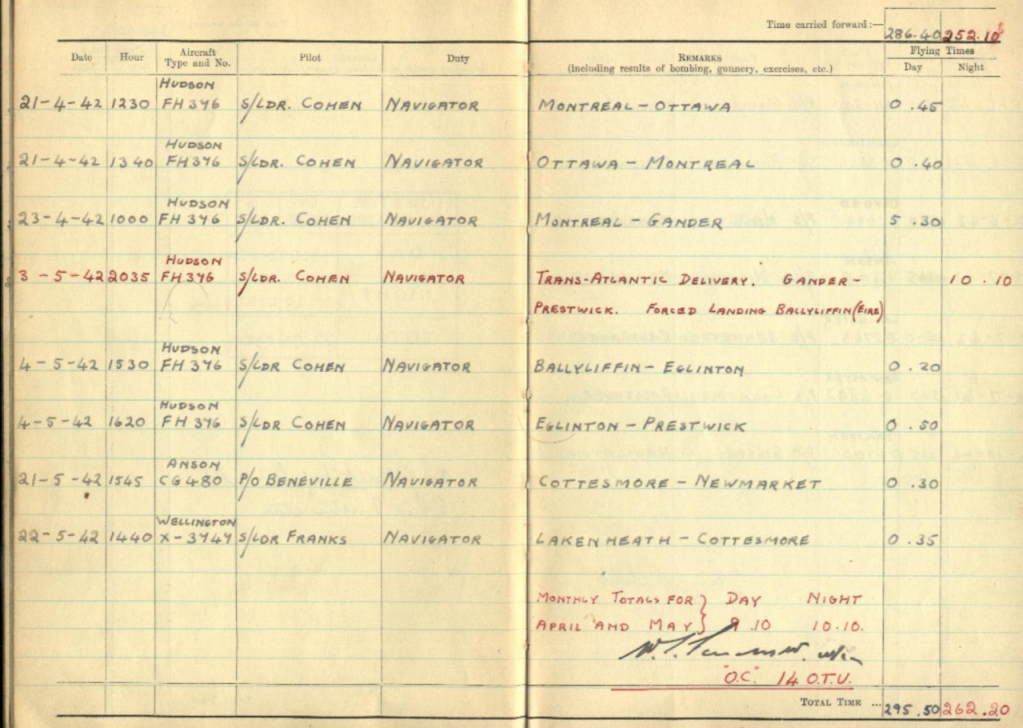
The aircraft, Lockheed Hudson Serial number FH376 was delivered to the Royal Air Force and is listed as having been assigned to 200 Squadron which was based at Jeswang, Gambia in Africa. In February 1943, this aircraft was transferred to the Free French Naval Air Arm in North Africa and was assigned the serial number 1BR-IV while flying with squadron 1BR alongside three other Hudson's. They served there until August 1943 when they were replaced with Vickers Wellingtons. It is not clear from available records what the ultimate fate of the aircraft was and if it served again with the RAF.
The map below compiled from the www.osi.ie website shows the two locations described on this page.
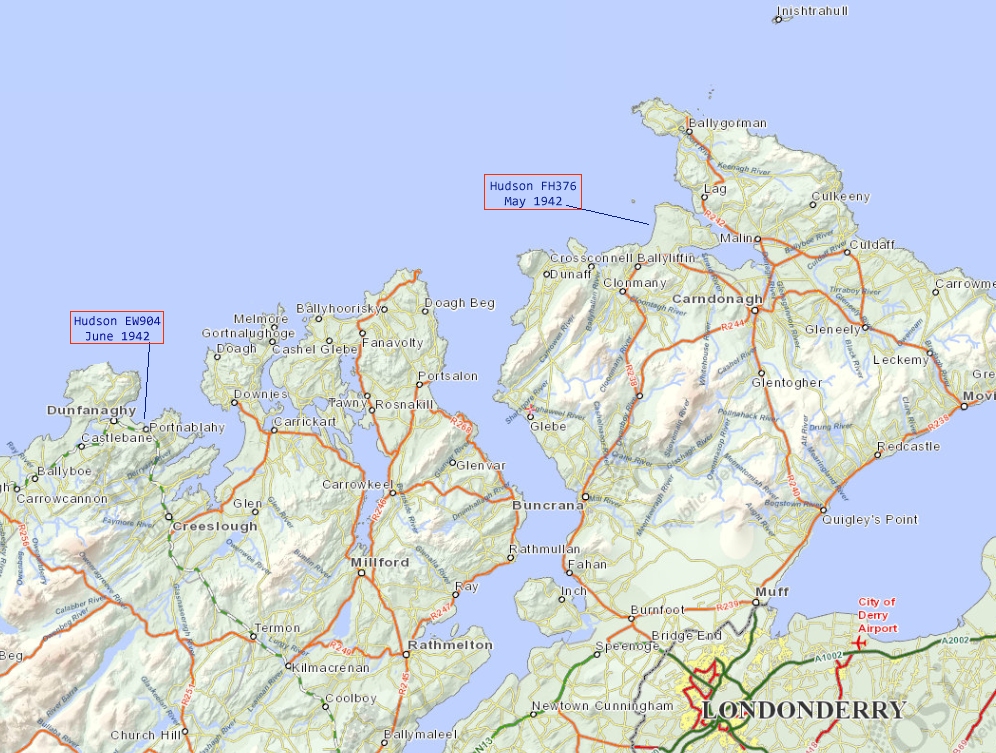
May 23rd, would see an altogether more tragic event when the crew of Hudson FH233 ditched in the sea off Sligo and were lost. Their sad story is told here on the website.
June 16th, 1942, Dunfanghy, Donegal
A few days later another of Lockheed's famous Hudson patrol bombers was forced to make an emergency landing on a beach near the town of Dunfanghy in the north of Donegal. On the 16 June 1942, at around 12:30 local time, an aircraft landed on "Hill Strand", near Dunfanaghy in Donegal Ireland. The crew of the aircraft consisted of four men in civilian attire who reported that they belonged to the 'British Ferry Command'. The local members of the Local Defense Force (LDF) made contact with the crew shortly after the landing and they placed a cordon around the aircraft. The crew refused to leave the aircraft at this time and insisted staying on the beach. Later members of the Irish Army arrived at the scene and took over the cordon. The Irish military recorded the aircraft as being a 'British Lockheed Hudson. Markings: "A 28 A. Air Corp Service 426613" Unarmed'.
The situation on the 16th of June was recorded on scraps of paper at head quarters in Dublin as the various military posts from Donegal to Athlone and on to Dublin, called in the events of the day. At 13:30 it was recorded: "Atlantic Ferry Command a/c has landed on strand at Dunfanaghy (N Donegal) at 12:30. L.D.F. have cordoned a/c. Crew of four, dressed in civilian attire are still on board and refuse to leave the plane. Mil(itary) Letterkennny are proceeding to Dunfanaghy"
The situation has clearly relaxed in the following hours as
another report reads: 'Plane made a perfect landing,
undamaged, expected that it is able to take off. Markings on
a/c A28A - Air Corps Service - 426613'. Crew now in Hotel at
Dunfanaghy with Lt. Galvin. Names - Capt. Leak
Mr. Ryan
Mr. Drinskonski
Mr. Cowieson
Some planes from N.I circled the position of the grounded
plane and number of times after it landed. Two of those planes
circled around Malin Hd Military Post and were fired on.'
These names were perhaps only written down phonetically and thus the third name was spelled wrong as was later discovered.
Later in the afternoon, the pilot was allowed by the military command to return to the aircraft to turn off some electrical fitting. This simple task however required a number of phone calls between headquarters in Dublin and the officers on the scene in order to get approval for the pilot to return to the aircraft. Finally, word was received from the Department of External Affairs that the crew and aircraft would be released and a lorry with fuel would be allowed across the border to top the Hudson up.
It seems that the four men stayed over night in a local hotel but it is not fully recorded. On the following day, the aircraft took off at 15:05 hrs after being refueled by a bowser sent from Northern Ireland. Karl Dzinkowski's flying log book shows that they flew on to Prestwick in Scotland.
The names of the crew were recorded as shown above and it has taken took some further research to try to confirm who the men were.
The Captain of the aircraft was recorded by Irish authorities as 'Captain Leak' only. It was assumed that he was an American civilian in the employ of what was then the RAF Ferry Command. The 1940 United States census was checked for any men named Leak or Leake who recorded their occupation as pilot or aviator. This is a feature made possible by ancestry.com's transcription of occupations in this valuable database. It would be assumed that most of the civilian contractors taken on by Ferry Command would be trained pilots in 1940, possibly flying with an airline. One possible name came up, an Ernest L Leak, aged 32 years and a pilot from Washington State, living in California and flying with an airline. This lead to the discovery that he had passed away in 1945 in California and was buried in his native state. By chance, the name of E L Leak was recorded on a passenger manifest of the SS Mosdale in March 1942, listed with a group of 'Ferry Pilots' traveling with the Air Ministry. Due to to sail from Glasgow to Halifax, his and two other names were struck off the manifest and must have continued their journey by other means. A query to the Directorate of History and Heritage in Canada who hold some of the personnel records of RAF Ferry Command and Ferry Group confirmed that indeed Ernest Lloyd Leak was employed by that organization during 1941 and the summer of 1942. A message on the findagrave.com website requesting a photograph of his grave brought forth the assistance of two generous Washington inhabitants, L Widing and J McClean. Both offered to travel to nearby libraries to obtain a copy of Ernest's 1945 obituary in The Tacoma News Tribune. Not only that but L Widing also tracked down none other than Ernest's grand daughter Jennifer. Her father David was Ernest's son, only 9 years of age when his father died. Among the first things that Jennifer was able to find among Ernest's remaining memorabilia was the post card shown below:
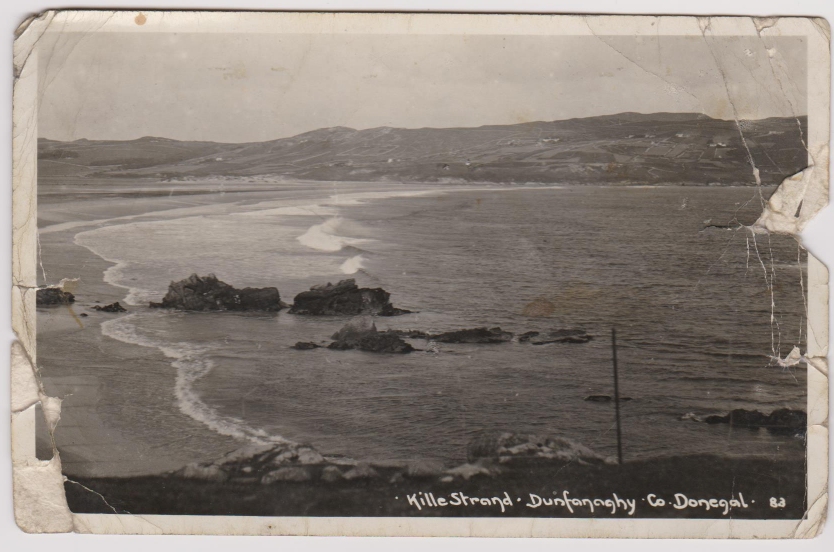
This surprising find of a post card of 'Killestrand' near
Dunfanaghy in the belongings of a former RAF Ferry Command pilot
would seem to confirm that Ernest Leak was indeed the pilot of
Hudson EW904 during its short visit to Donegal. The post card
was never posted or written on except for the following note, Yakima
4149 Ray of which more later. Also among his things was a
certificate of flying hours signed by an officer of the RAF
Ferry Command showing his last flight with them to have been a
June 12th to June 16th ferry of a Hudson aircraft, from Montreal
to Newfoundland and thence to the United Kingdom. Total flying
time for this trip was, 5hrs 40mins from Montreal to
Newfoundland and 12 hrs 50 mins from there to the United
Kingdom. While the certificate does not list the aircraft serial
number, the flight duration's and locations match up with the
times shown in Sgt Dzinkowski's flight log shown below though
the flights appear to start on the 9th of June in the log book.
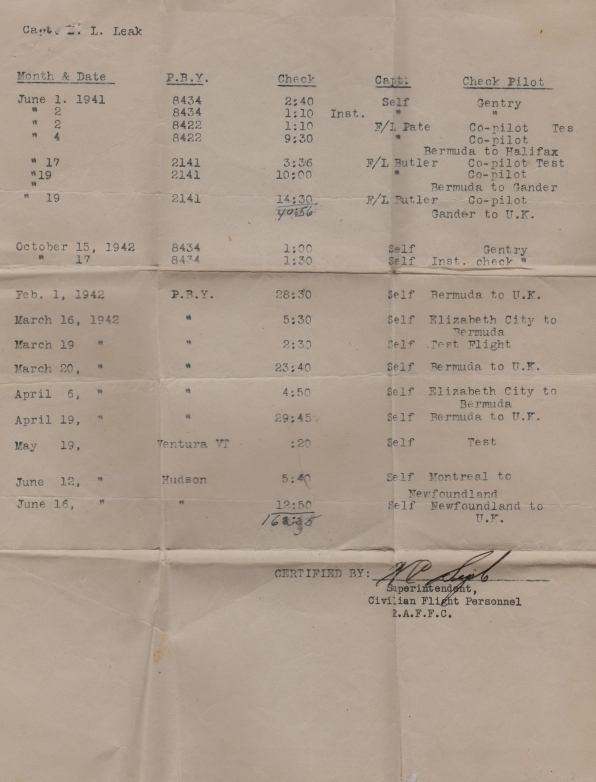
 Ernest Leak
passed away at the young age of 37 and his native Tacoma
newspaper carried the following obituary for him:
Ernest Leak
passed away at the young age of 37 and his native Tacoma
newspaper carried the following obituary for him:
DEATH COMES TO FLIER AFTER LONG SERVICE
Earnest Lloyd Leak, 37, former Tacoma and Puyallup man,
whose service as a pilot in the naval air reserve, as a
commercial mail and passenger pilot, captain in the RAF
ferrying command and lieutenant in the air transport service
has mounted up to many years, died April 13 at Los Angeles.
About a year ago he was released from the air transport
service due to the illness which last week caused his death.
Puyallup was his birth place. A graduate of Lincoln high
school in Tacoma where he was a letterman on the wrestling
team, Leak entered the University of Washington. Alpha Sigma
Phi was his fraternity. During his senior year he took his
navy preflight training afterwards being sent to Sand Point
naval air station in Seattle, where later he received his
commission as ensign. At North Island, San Diego, and at sea
on the aircraft carrier Lexington, Leak served two years, then
entered the commercial field. He shared in the pioneering of
airmail and passenger plane service. Leak was a charter member
of the Air Line Pilots association.
A year and a half before the United States entered the
war Leak flew bomber from Montreal to England. Also he flew
Catalina flying boats between Bermuda and England, holding the
rank of captain in the RAF ferrying command. While in Bermuda,
he contracted malaria and dengue fever, which recurred
frequently. Leak returned to the west coast upon United States
entry into the war, re-entering the navy to serve as a
lieutenant in the air transport service until his retirement
about a year ago.
Surviving are his wife, Mildred; son, David; parents,
Mr. and Mrs. E. J. Leak, of Leak’s Place on the Seattle-Tacoma
highway, and a sister, Gladys Swanberg, of Seattle. Private
funeral services will be held Thursday or Friday afternoon at
the Hill Funeral home in Puyallup; entombment in Woodlawn
abbey mausoleum.
The Tacoma News Tribune, April 1945
The documents found by his grand daughter show that during
1943 Ernest was flying with the US Navy as a transport pilot on
routes in the Aleutian Islands off the coast of Alaska. This may
account for the hand written inscription on the back of the
postcard, Yakima was an air base in Washington state that he may
have been passing through or had a beacon to be homed in on. His
earlier service record from RAF Ferry Command show at least four
Catalina deliveries to the UK during 1941 and 1942. At least one
of these would have positioned him in the UK for the shipping
manifest in March 1942. It is noted that his early check pilot
may have been the famed Ferry pilot Dana L Gentry who was one of
the pilots on the first ever Ferry mission in November 1940.
In 1940, Ernest was required to register for the draft and at
that time in October 1940 he recorded that he was flying for
"Mid-Continent Air Lines".
Ernest's son David himself became a pilot and flew with the US
Navy. Ernest had served during 1928 and 1929 with US Navy
Squadron VB-1B, flying from the USS Lexington using the likes of
the Martin T4M biplane Torpedo bomber.
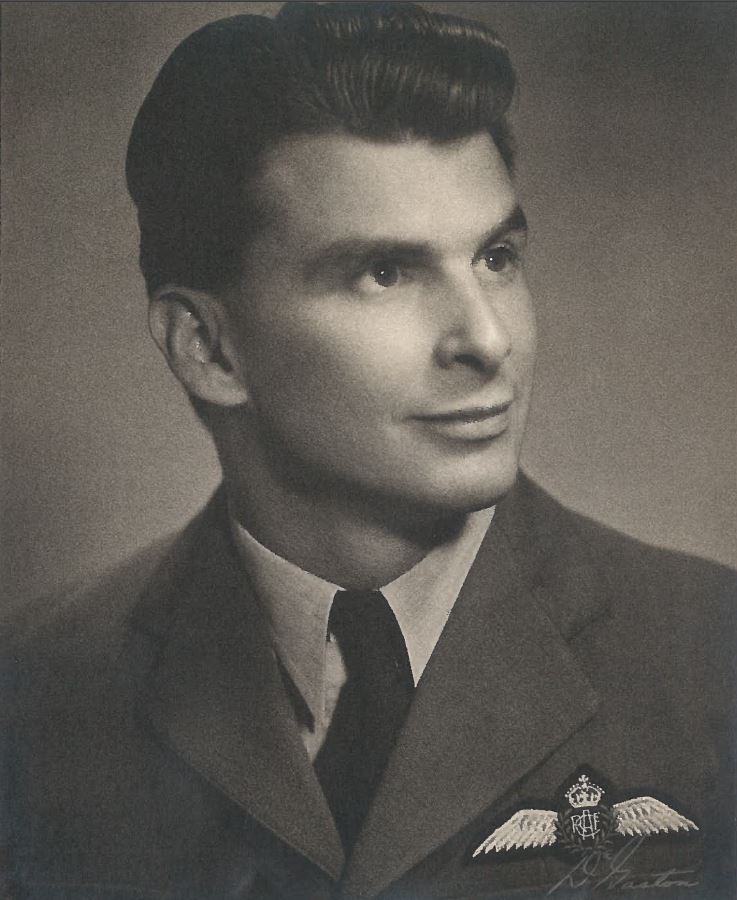 The second
recorded occupant of the aircraft was recorded by the Irish Army
simply as the surname Ryan. The Directorate of History and
Heritage were in 2018 able to find among the various Ryan's in
their files, the Ferry Command card for P/O Albert Sydney
Ryan, RCAF J10816, a newly trained pilot having graduated
from 12 SFTS in March 1943.
The second
recorded occupant of the aircraft was recorded by the Irish Army
simply as the surname Ryan. The Directorate of History and
Heritage were in 2018 able to find among the various Ryan's in
their files, the Ferry Command card for P/O Albert Sydney
Ryan, RCAF J10816, a newly trained pilot having graduated
from 12 SFTS in March 1943.
Albert was born to Walter and Rosina Ryan in Camberwell, London
in late 1915. The family moved to America and set up life
in New York City. In Sep 1938, Albert was awarded his
American Citizenship, and was working as a machinist in new York
at the time of the 1940 Federal Census.
EW904 was his first recorded Ferry Flight and thereafter flew
regular delivery flights to the Middle East, Africa, Australia,
Brazil and the Bahamas. His tour ended at the end November 1943
and he was posted elsewhere.
Albert passed away in 1997 in Solana Beach, California.
A crew of four was not common on Hudson's which came down in
Ireland. Indeed of the six Ferry Command Hudsons, only EW904
carried four men. The story of FH376 is told above, that of FH233 at this link, AM864 is described here, the loss of AE577 is told here and some details
of FH263 are told on this page.
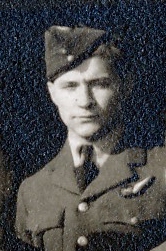
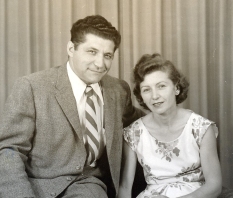 The 'Mr
Drinkonski' turned out to be Sergeant "Karl Edward
DZINKOWSKI" R101827. A 22 year old Canadian Radio
Operator/Air Gunner from Winnipeg. After his training and
graduation from 2 Bombing and Gunnery School his first posting
was to Ferry Command and 31 Operational Training Unit. The
delivery flight with Hudson EW904 was his first ferry flight.
His return to America and Canada was on board the SS Vaalaren
arriving in New York in July. Shortly after this Karl was
seriously injured in an aircraft crash that earned him a British
Empire Medal for bravery. The citation for his award was
published in the London Gazette, Issue 35765, 30th October 1942.
This and his service career are recorded on the Canadian
Awards Website.
The 'Mr
Drinkonski' turned out to be Sergeant "Karl Edward
DZINKOWSKI" R101827. A 22 year old Canadian Radio
Operator/Air Gunner from Winnipeg. After his training and
graduation from 2 Bombing and Gunnery School his first posting
was to Ferry Command and 31 Operational Training Unit. The
delivery flight with Hudson EW904 was his first ferry flight.
His return to America and Canada was on board the SS Vaalaren
arriving in New York in July. Shortly after this Karl was
seriously injured in an aircraft crash that earned him a British
Empire Medal for bravery. The citation for his award was
published in the London Gazette, Issue 35765, 30th October 1942.
This and his service career are recorded on the Canadian
Awards Website.
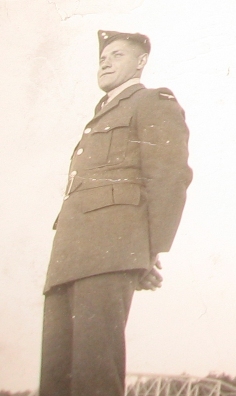 |
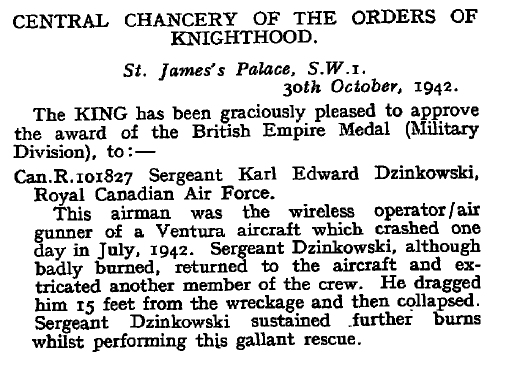 |
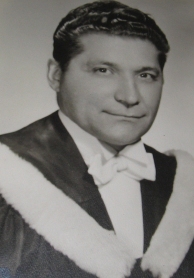 |
It is this event, the crash of a Ventura bomber that explains the burnt edges of Karl's flying log book shown below.
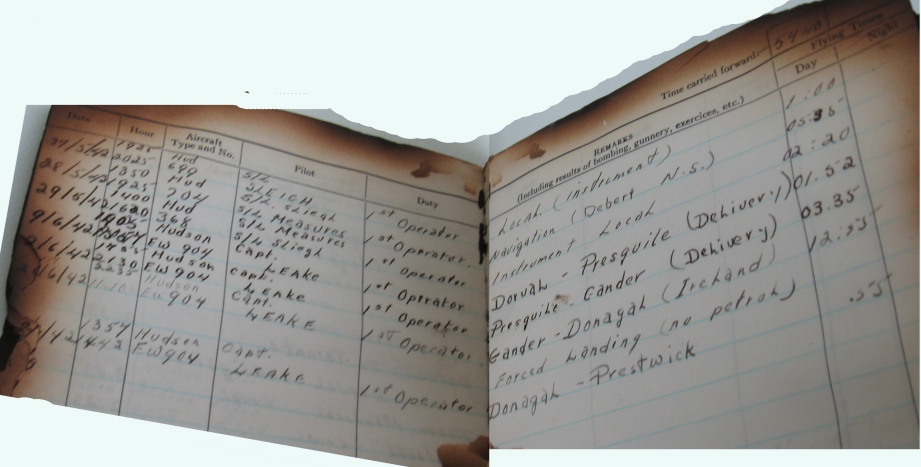
The above composite image from Karl's daughter shows the
details of the flight, it having taken them thirteen hours to
fly from Gander in Newfoundland to Donegal. Their subsequent
flight from Donegal took them to Prestwick in Scotland, their
original destination. Karl recovered from his injuries and
returned to flying with Ferry Command and its later replacement,
45 Group, Transport Command. He was promoted to Officer rank in
1944. Karl became a lawyer after the war and passed away in
1996.
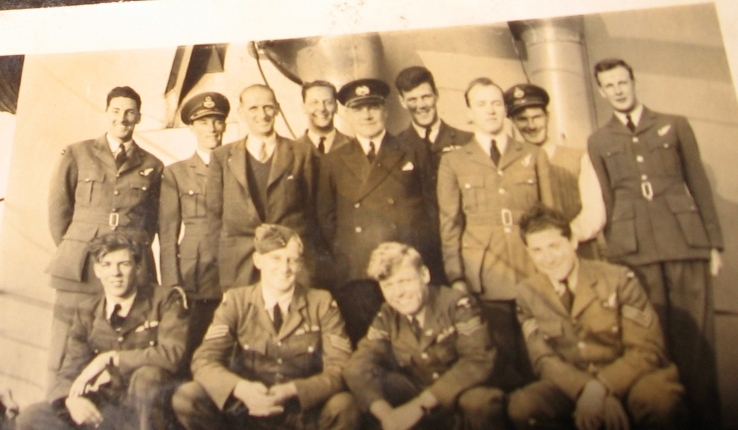 The photo at left
shows Karl Dzinkowski on a ship with other air force members. On
the shipping record for July 1942 on the SS Vaaleren karl sailed
with a group of 11 other airmen and there are eleven airmen in
this group of thirteen men. The names of the 11 airmen on that
shipping list are:
The photo at left
shows Karl Dzinkowski on a ship with other air force members. On
the shipping record for July 1942 on the SS Vaaleren karl sailed
with a group of 11 other airmen and there are eleven airmen in
this group of thirteen men. The names of the 11 airmen on that
shipping list are:
P/O Sammy Birch
P/O Murray M Young
Sgt. Arthur D Gavel
Obs Ernest Biss
Sgt Harold Bancroft
P/O Allan G McRae
P/O Warren V Miller
P/O Alfred H Waters
Sgt William E Bristow
Sgt Frank Bishop
Sgt Karl E Dzinkowski
Also with the group was a 50 year old marine surveyor named
William H Dilworth. Of the men on that list, A D Gavel of the
RCAF would be killed in an aircraft accident in 1944, detailed
on this
page with a photo. His photo on that page is at rank of
Sergeant, whereas he ought to be an officer in the Dzinkowski
photo.
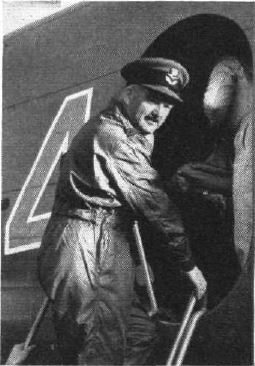 The navigator on
the aircraft was Pilot Officer Peter Cowieson, 123885 of
the RAF Volunteer Reserve. Born in Dalkeith in 1916 to Janet and
Peter Tertius Cowieson.
The navigator on
the aircraft was Pilot Officer Peter Cowieson, 123885 of
the RAF Volunteer Reserve. Born in Dalkeith in 1916 to Janet and
Peter Tertius Cowieson.
This flight on EW904 was the only Ferry Flight recorded on his
Ferry Command assignment card. He married on 14th November 1942
to Jean MacKenzie Fortune in Edinburgh, Scotland. The
marriage record states his profession was Pharmaceutical
Chemist, but currently a Pilot officer, RAF. It is
expected that he transferred to a combat unit but his name has
not yet been found in a wartime RAF Squadron ORB.
His name was published in the London Gazette on the 25 August
1942 announcing his promotion from the rank of Leading
Aircraftman to Pilot Officer. This was followed on the
London Gazette of 7th May 1943 with the promotion to Flying
Officer, and again to Flight Lieutenant on the 14 July 1944
Gazette. He remained in the RAF throughout the war and his
promotion to the permanent rank of Flight Lieutenant was
published in 1947, he having previously been a war time RAFVR.
In 1957, he was the Squadron Navigation Leader with 224 Squadron
of Coastal Command based in Gibralter and flew on a tour of
South America by four of the Squadrons Avro Shackletons patrol
aircraft. In this capacity, he appears in a photo in
Flight Magazine in March 1957, and that, the only photo so far
found, is shown above. He had been posted into the
Squadron on 16 May 1956 from 236 Operational Conversion
Unit. He left the unit in November 1958.
He passed away in Huntingdon in early 1995 and his wife Jean
just two years later.
Contact has been made with his family and it is hoped to expand
on his story in due course.
Seeking Photo.
The aircraft itself, a Lockheed Hudson Mark VI, went on to
serve with 320 (Dutch) Squadron of the RAF and then to 279
Squadron in early 1943. Local business man Brendan Rohan
was the driving force in 2014 behind an effort to fully research
and document the incident. He self published a book in
2016 entitled:
In 2017 he was able to find, from the local community, the
following two photos showing EW904 in all its splendor on the
beach at Dunfanghy.
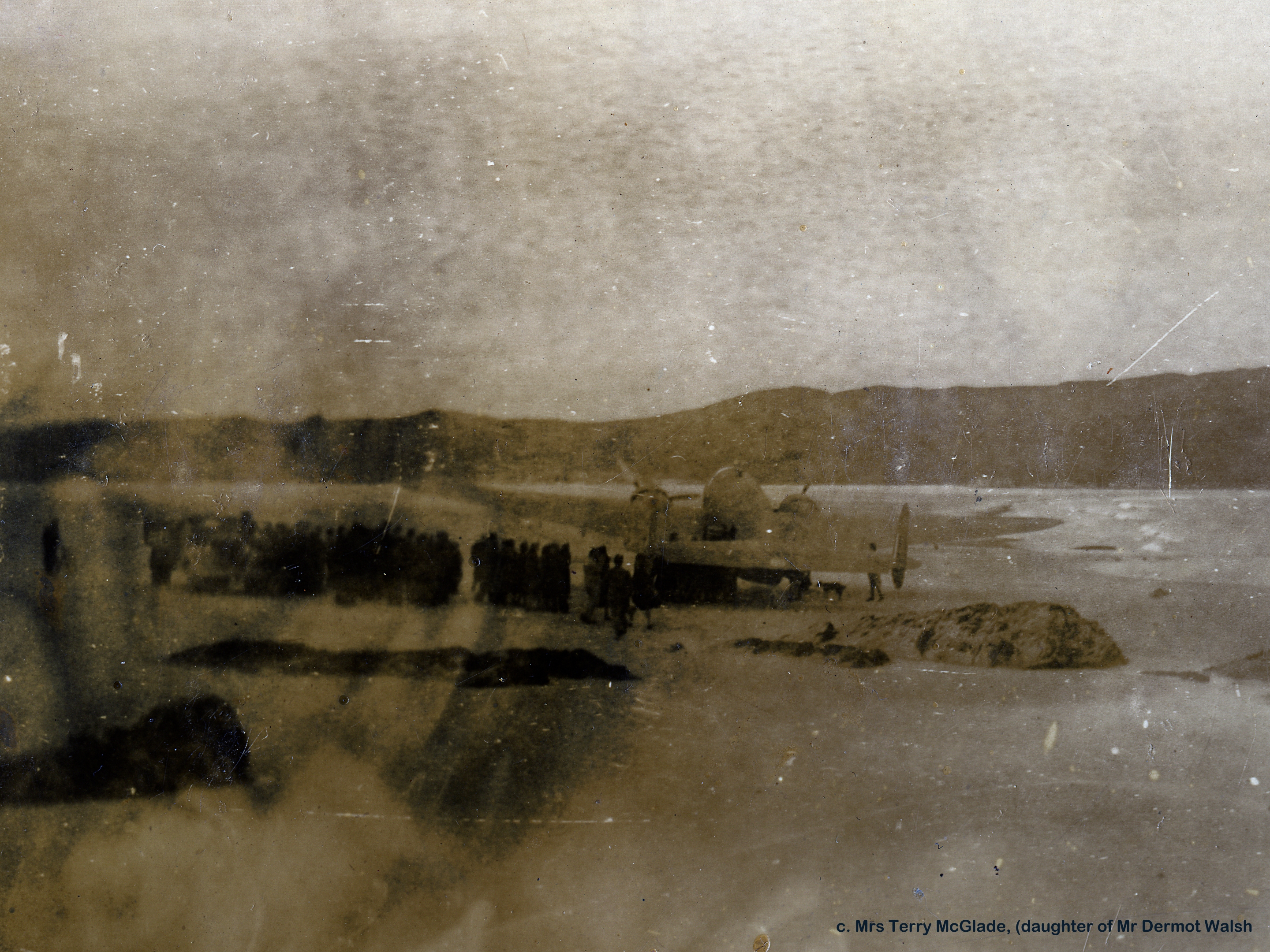
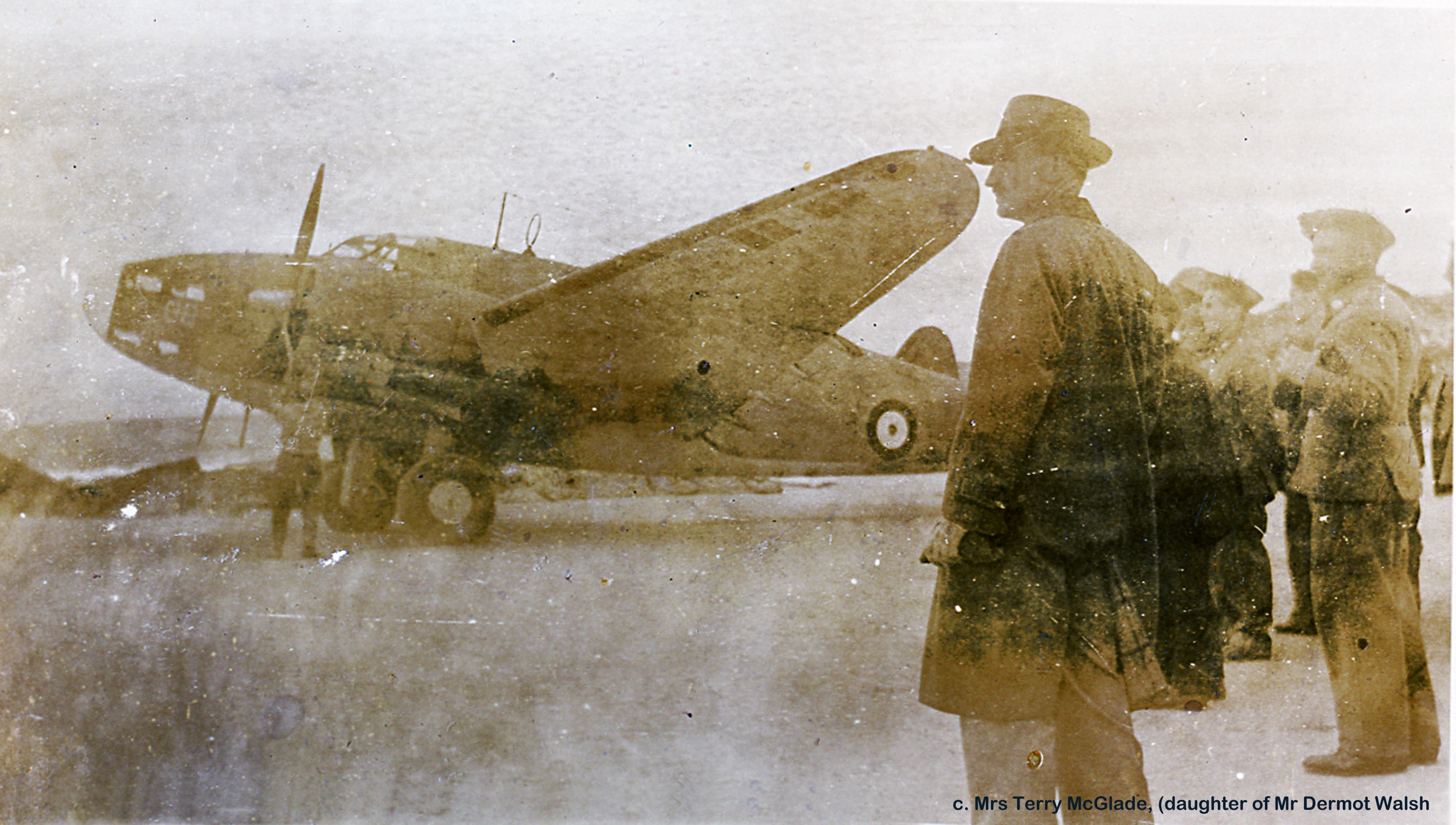
Brendan was able to get these from Mrs Terry McGlade, (daughter
of Mr Dermot Walsh who who entertained and accommodated the crew
of the aircraft on 16 June 1942).
On the 16th June 2014, the local community in Dunfanaghy welcomed back to their village representatives of the British, Canadian and American Armed forces along with the Irish Defense Forces to hold a memorial to remember the members of the crew of Hudson EW904 and their lucky escape. They were joined by the daughter of Karl Dzinkowski who as guest of honor, unveiled a beautiful new memorial to the crew and their exploits. It is a timely reminder that not all the wartime landings were tragic occasions. The events were broadcast on the RTE national News and this is presented below from youtube
